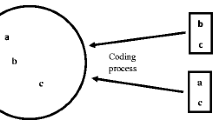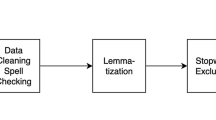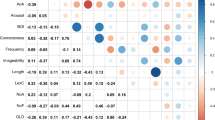Abstract
To study linguistically coded concepts, researchers often resort to the Property Listing Task (PLT). In a PLT, participants are asked to list properties that describe a concept (e.g., for DOG, subjects may list “is a pet”, “has four legs”, etc.). When PLT data is collected for many concepts, researchers obtain Conceptual Properties Norms (CPNs), which are used to study semantic content and as a source of control variables. Though the PLT and CPNs are widely used across psychology, only recently a model that describes the listing course of a PLT has been developed and validated. That original model describes the listing course using order of production of properties. Here we go a step beyond and validate the model using response times (RT), i.e., the time from cue onset to property listing. Our results show that RT data exhibits the same regularities observed in the previous model, but now we can also analyze the time course, i.e., dynamics of the PLT. As such, the RT validated model may be applied to study several similar memory retrieval tasks, such as the Free Listing Task, Verbal Fluidity Task, and to research related cognitive processes. To illustrate those kinds of analyses, we present a brief example of the difference in PLT’s dynamics between listing properties for abstract versus concrete concepts, which shows that the model may be fruitfully applied to study concepts.




Similar content being viewed by others
References
Abwender DA, Swan JG, Bowerman JT, Connolly SW (2001) Qualitative analysis of verbal fluency output: review and comparison of several scoring methods. Assessment 8(3):323–336. https://doi.org/10.1177/107319110100800308
Ashby FG, Alfonso-Reese LA (1995) Categorization as probability density estimation. J Math Psychol 39(2):216–233. https://doi.org/10.1006/jmps.1995.1021
Atkinson RC, Shiffrin RM (1968) Human memory: a proposed system and its control processes. In: Spence KW, Spence JT (eds) The psychology of learning and motivation: advances in research and theory, vol 2. Academic Press, New York, pp 89–195
Balota DA, Spieler DH (1999) Word frequency, repetition, and lexicality effects in word recognition tasks: beyond measures of central tendency. J Exp Psychol General 128(1):32–55. https://doi.org/10.1037/0096-3445.128.1.32
Bolognesi M, Pilgram R, van den Heerik R (2016) Reliability in content analysis: the case of semantic feature norms classification. Behav Res Methods 49(6):1984–2001. https://doi.org/10.3758/s13428-016-0838-6
Borghi AM, Binkofski F, Castelfranchi C, Cimatti F, Scorolli C, Tummolini L (2017) The challenge of abstract concepts. Psychol Bull 143(3):263–292. https://doi.org/10.1037/bul0000089
Bousfield WA, Sedgewick CHW (1944) An analysis of sequences of restricted associative responses. J General Psychol 30(2):149–165
Bowman AW, Azzalini A (1997) Applied smoothing techniques for data analysis: the kernel approach with S-plus illustrations. Oxford University Press, Oxford
Canessa E, Chaigneau SE (2020) Mathematical regularities of data from the property listing task. J Math Psychol. https://doi.org/10.1016/j.jmp.2020.10237
Canessa E, Chaigneau SE, Lagos R, Medina FA (2021) How to carry out conceptual properties norming studies as parameter estimation studies: lessons from ecology. Behav Res Methods 53(1):354–370. https://doi.org/10.3758/s13428-020-01439-8
Canessa E, Chaigneau SE, Moreno S, Lagos R (2022) CPNCoverageAnalysis: an R package for parameter estimation in conceptual properties norming studies. Behav Res Methods. https://doi.org/10.3758/s13428-022-01811-w
Chaigneau SE, Canessa E, Barra C, Lagos R (2018) The role of variability in the property listing task. Behav Res Methods 50(3):972–988. https://doi.org/10.3758/s13428-017-0920-8
Cohen J (1960) A coefficient of agreement for nominal scales. Educ Psychol Meas 20(1):37–46. https://doi.org/10.1177/001316446002000104
Conway ARA, Engle RW (1994) Working memory and retrieval: a resource-dependent inhibition model. J Exp Psychol Gen 123(4):354–373. https://doi.org/10.1037/0096-3445.123.4.354
Devereux BJ, Tyler LK, Geertzen J, Randall B (2014) The centre for speech, language and the brain (CSLB) concept property norms. Behav Res Methods 46(4):1119–1127. https://doi.org/10.3758/s13428-013-0420-4
Goldstone RL (1994) Influences of categorization on perceptual discrimination. J Exp Psychol General 123(2):178–200. https://doi.org/10.1037/0096-3445.123.2.178
Griffiths TL, Sanborn AN, Canini KR, Navarro DJ (2008) Categorization as nonparametric bayesian density estimation. In: Oaksford M, Chater N (eds) The probabilistic mind: prospects for rational models of cognition. Oxford University Press, Oxford
Hallgren KA (2012) Computing inter-rater reliability for observational data: an overview and tutorial. Tutor Quant Methods Psychol 8(1):23–34
Hills TT, Todd PM, Jones MN (2015) Foraging in semantic fields: how we search through memory. Top Cogn Sci 7(3):513–534. https://doi.org/10.1111/tops.12151
Hoffman P, Lambon Ralph MA, Rogers TT (2013) Semantic diversity: a measure of semantic ambiguity based on variability in the contextual usage of words. Behav Res Methods 45(3):718–730. https://doi.org/10.3758/s13428-012-0278-x
Hough G, Ferraris D (2010) Free listing: A method to gain initial insight of a food category. Food Qual Prefer 21(3):295–301. https://doi.org/10.1016/j.foodqual.2009.04.001
Jones GV (1985) Deep dyslexia, imageability, and ease of predication. Brain Lang 24:1–19. https://doi.org/10.1016/0093-934X(85)90094-X
Kane MJ, Engle RW (2000) Working-memory capacity, proactive interference, and divided attention: limits on long-term memory retrieval. J Exp Psychol Learn Mem Cogn 26(2):336–358. https://doi.org/10.1037/0278-7393.26.2.336
Keppel G, Underwood BJ (1962) Proactive inhibition in short-term retention of single items. J Verbal Learn Verbal Behav 1(3):153–161. https://doi.org/10.1016/S0022-5371(62)80023-1
Kremer G, Baroni M (2011) A set of semantic norms for german and italian. Behav Res Methods 43(1):97–109. https://doi.org/10.3758/s13428-010-0028-x
Landis JR, Koch GG (1977) The measurement of observer agreement for categorical data. Biometrics 33(1):159–174. https://doi.org/10.2307/2529310
Lenci A, Baroni M, Cazzolli G, Marotta G (2013) BLIND: A set of semantic feature norms from the congenitally blind. Behav Res Methods 45(4):1218–1233. https://doi.org/10.3758/s13428-013-0323-4
Maki WS (2007) Judgments of associative memory. Cogn Psychol 54(4):319–353. https://doi.org/10.1016/j.cogpsych.2006.08.002
Mazzuca C, Majid A, Lugli L, Nicoletti R, Borghi AM (2020) Gender is a multifaceted concept: evidence that specific life experiences differentially shape the concept of gender. Lang Cogn 12(4):649–678. https://doi.org/10.1017/langcog.2020.15
McRae K, Cree GS, Seidenberg MS, Mcnorgan C (2005) Semantic feature production norms for a large set of living and nonliving things. Behav Res Methods 37(4):547–559. https://doi.org/10.3758/BF03192726
Montefinese M, Ambrosini E, Fairfield B, Mammarella N (2013) Semantic memory: a feature-based analysis and new norms for Italian. Behav Res Methods 45(2):440–461. https://doi.org/10.3758/s13428-012-0263-4
Perri R, Zannino G, Caltagirone C, Carlesimo GA (2012) Alzheimer’s disease and semantic deficits: a feature-listing study. Neuropsychology 26(5):652–663. https://doi.org/10.1037/a0029302
Plaut DC, Shallice T (1993) Deep dyslexia: a case study of connectionist neuropsychology. Cogn Neuropsychol 10:377–500
Polyn SM, Norman KA, Kahana MJ (2009) A context maintenance and retrieval model of organizational processes in free recall. Psychol Rev 116(1):129–156
Raaijmakers JGW, Shiffrin RM (1980) SAM: a theory of probabilistic search of associative memory. In: Bower GH (ed) The psychology of learning and motivation: advances in research and theory, vol 14. Academic Press, New York, pp 207–262
Raaijmakers JG, Shiffrin RM (1981) Search of associative memory. Psychol Rev 88(2):93–134. https://doi.org/10.1037/0033-295X.88.2.93
Recchia G, Jones MN (2012) The semantic richness of abstract concepts. Front Hum Neurosci 6:315. https://doi.org/10.3389/fnhum.2012.00315
Rosen VM, Engle RW (1997) The role of working memory capacity in retrieval. J Exp Psychol Gen 126(3):211–227
Shiffrin RM, Raaijmakers J (1992) The SAM retrieval model: A retrospective and prospective. In: Healy AF, Kosslyn SM, Shiffrin RM (eds) Essays in honor of William K. Estes, Vol. 1. From learning theory to connectionist theory; Vol. 2. From learning processes to cognitive processes. Lawrence Erlbaum Associates Inc, New York, pp 69–86
Schyns PG, Goldstone RL, Thibaut J (1998) The development of features in object concepts. Behavioral and Brain Sciences 21(1):1–54. https://doi.org/10.1017/S0140525X98000107
Sunohara M, Sasaki J, Kogo S, Ryder AG (2022) Japanese clinical psychologists’ consensus beliefs about mental health: A mixed-methods approach. Jpn Psychol Res. https://doi.org/10.1111/jpr.12410
Thurstone LL (1938) Primary mental abilities. University of Chicago Press
Troyer AK (2000) Normative data for clustering and switching on verbal fluency tasks. J Clin Exp Neuropsychol 22(3):370–378
Tversky A, Hutchinson JW (1986) Nearest neighbor analysis of psychological spaces. Psychol Rev 93(1):3–22. https://doi.org/10.1037/0033-295X.93.1.3
Vivas J, Vivas L, Comesaña A, García Coni A, Vorano A (2017) Spanish semantic feature production norms for 400 concrete concepts. Behav Res Methods 49(3):1095–1106. https://doi.org/10.3758/s13428-016-0777-2
Vivas J, Kogan B, Yerro M, Romanelli S, Vivas L (2021) Describing the structure of concepts through different feature levels. J Cogn Psychol 33:1. https://doi.org/10.1080/20445911.2020.1858840
Walker LJ, Hennig KH (2004) Differing conceptions of moral exemplarity: just, brave, and caring. J Pers Soc Psychol 86(4):629–647. https://doi.org/10.1037/0022-3514.86.4.629
Weiler SM, Jacobsen T (2021) “I’m getting too old for this stuff”: The conceptual structure of tattoo aesthetics. Acta Psychol 219:234. https://doi.org/10.1016/j.actpsy.2021.103390
Wickens DD, Born DG, Allen CK (1963) Proactive inhibition and item similarity in short-term memory. J Verbal Learn Verbal Behav 2(5–6):440–445. https://doi.org/10.1016/S0022-5371(63)80045-6
Wickens DD, Dalezman RE, Eggemeier FT (1976) Multiple encoding of word attributes in memory. Mem Cognit 4(3):307–310. https://doi.org/10.3758/BF03213181
Wickens DD, Moody MJ, Dow R (1981) The nature and timing of the retrieval process and of interference effects. J Exp Psychol Gen 110(1):1–20. https://doi.org/10.1037/0096-3445.110.1.1
Wu LL, Barsalou LW (2009) Perceptual simulation in conceptual combination: evidence from property generation. Acta Physiol (oxf) 132:173–189. https://doi.org/10.1016/j.actpsy.2009.02.002
Yap MJ, Pexman PM (2016) Semantic richness effects in syntactic classification: the role of feedback. Front Psychol. https://doi.org/10.3389/fpsyg.2016.01394
Funding
This research was carried out with funds provided by Agencia Nacional de Investigación y Desarrollo (ANID), Fondo Nacional de Desarrollo Científico y Tecnológico (FONDECYT) of the Chilean government grant 1200139. Additionally, the authors received financial support from the James S. McDonnell Foundation, project "A method for studying shared meaning in cultural groups" https://doi.org/10.37717/2022-3930.
Author information
Authors and Affiliations
Contributions
All authors contributed to the study conception and design. Material preparation, data collection and analysis were performed by EC, SC, and SM. The first draft of the manuscript was written by EC and SC and all authors commented on previous versions of the manuscript. All authors read and approved the final manuscript.
Corresponding author
Ethics declarations
Conflict of interest
The authors declare to have no known conflict of interests regarding the work being reported here.
Informed consent
All participants in this study gave informed written consent and the study was approved by the Universidad Adolfo Ibáñez research ethics committee.
Additional information
Publisher's Note
Springer Nature remains neutral with regard to jurisdictional claims in published maps and institutional affiliations.
Editors: Moreno I. Coco (Sapienza University of Rome), Nicholas D. Duran (Arizona State University); Reviewers: Lang Chen (Santa Clara University), Jorge Vivas (National University of Mar del Plata.
Rights and permissions
Springer Nature or its licensor (e.g. a society or other partner) holds exclusive rights to this article under a publishing agreement with the author(s) or other rightsholder(s); author self-archiving of the accepted manuscript version of this article is solely governed by the terms of such publishing agreement and applicable law.
About this article
Cite this article
Canessa, E., Chaigneau, S.E. & Moreno, S. Describing and understanding the time course of the property listing task. Cogn Process 25, 61–74 (2024). https://doi.org/10.1007/s10339-023-01160-2
Received:
Accepted:
Published:
Issue Date:
DOI: https://doi.org/10.1007/s10339-023-01160-2




